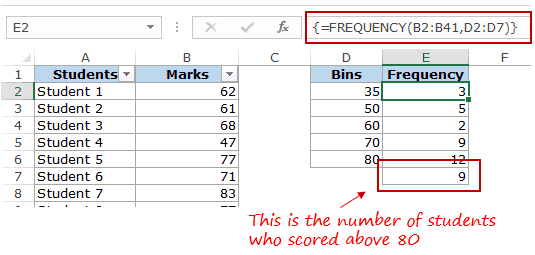

Lastly, you will get the Bin Range and Bin Counts just like in the below image. Uncheck the Starting at and Ending at boxes and select 5 in the By box. Eventually, a pivot table will appear in the sheet, and right-click on any cell of the table and pick Group.A Value Field Settings dialog box will pop out.of Students drop-down of the ∑Values and select Value Field Settings. A PivotTable Fields sidebar will show.PivotTable from table or range will appear and make the Table/Range as Sheet1!$C$5:$C$15 > check the Existing Worksheet box > create the Location in Sheet1!$E$4.

Initially, select your entire data range > go to Insert tab > choose Pivot Table.It will automatically create the range of your dataset. You can get and calculate the Bin Range by creating a PivotTable. Calculate Percentage Range in Excel (Step-by-Step Guide).How to Calculate Interquartile Range in Excel (2 Suitable Ways).Lastly, your result will look like the image below. This function finds the numerical values under the range of E5:E11, makes a count, and displays them. In the beginning, go to cell E5 and insert the formula Here, we have demonstrated to you the steps to be followed to use it. For example, using the MAX and MIN functions is one of them. There are quite handy methods for finding out the highest and lowest values of a certain dataset. It means finding the upper and lower values of your dataset and then making the intervals according to your preferences. To calculate the Bin Range, you have to calculate the Bins first. You can use any other version at your convenience. Not to mention, we have used the Microsoft 365 version. of Students under different Departments to calculate the Bin Range. We tried to cover all the methods for doing it. There are several ways to calculate the Bin Range. You see that from 1 to 5, there are 7 data (1, 2, 2, 2, 3, 3, 3) and from 6 to 10, there are two data (6 and 10).Ĥ Methods to Calculate Bin Range in Excel So, if you want to divide this dataset range into two intervals, each interval will be 5 (rounded value of (10-1)/2 or 4.5) units long. Here, the maximum and minimum numbers of the dataset are 10 and 1, respectively. The bins (intervals) must be close together and frequently be the same size.įor instance, you have this dataset: 1, 2, 2, 3, 3,6, 2, 10, 3. We can define the bins as discrete intervals that don’t overlap. Then we count the number of values that fall into each gap.

This Bin means dividing the dataset into a series of intervals. The first stage in creating a histogram is to bin the range of values. The distribution of numerical data is roughly depicted by a histogram.


 0 kommentar(er)
0 kommentar(er)
